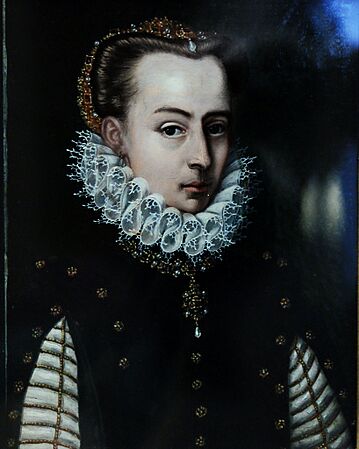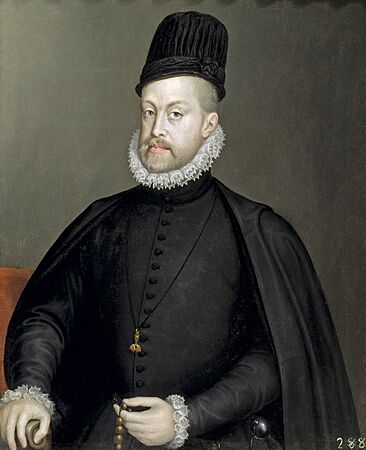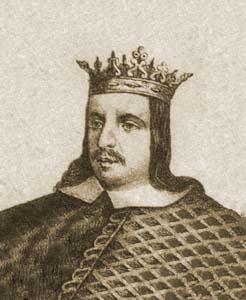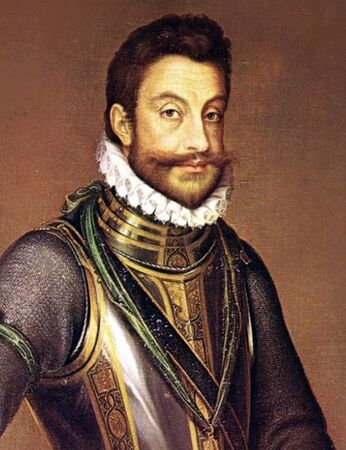Portuguese succession crisis of 1580 facts for kids
Portugal faced a big problem in 1580. Their young king, Sebastian I, died in a battle in 1578. His great-uncle, King Henry I, took over but also died in 1580. Neither king had children, so there was no clear heir to the throne. This led to a big fight, both inside Portugal and with other countries, as many people wanted to become the new king. Some even pretended to be King Sebastian, as his body was never found. Finally, King Philip II of Spain took control. This joined Portugal and Spain under one ruler for 60 years, called the Iberian Union. During this time, Portugal's empire faced many challenges, especially from the Dutch.
Contents
Who Was the Cardinal-King of Portugal?
King Henry, Sebastian's great-uncle, became ruler right after Sebastian died. Henry had helped rule Portugal for Sebastian since 1562. He became king after the terrible Battle of Alcácer Quibir in 1578, where Sebastian was lost. Henry was a cardinal, a high-ranking church official. He tried to give up his church duties to get married and have children. This would have kept the royal family line going. However, Pope Gregory XIII, who was friendly with the Spanish royal family, did not let him. The Cardinal-King died two years later without choosing a new ruler.
Who Wanted to Be the Next King?
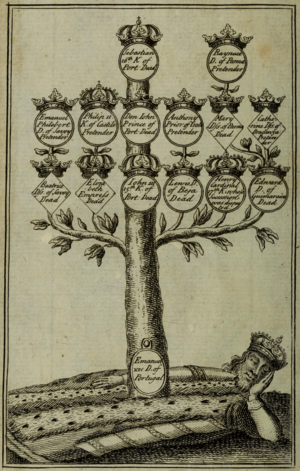
Portuguese nobles were worried about keeping their country independent. They looked for a new king. Many people claimed they had the right to the Portuguese throne. Here are some of the main people who wanted to be king or queen:
-
Ranuccio Farnese
Duke of Parma -
Philip II
King of Spain -
António of Portugal
Prior of Crato -
Emmanuel Philibert
Duke of Savoy
The family of the Duchess of Braganza eventually got the throne in 1640. But in 1580, she was just one of many possible heirs.
Who Was Ranuccio Farnese?
Ranuccio Farnese, who was 11 years old, was the grandson of Prince Edward of Portugal. Prince Edward was the only son of King Manuel I who had living children. This meant Ranuccio was the rightful heir to the throne based on family rules (primogeniture). However, Ranuccio's father was an ally of the Spanish king, Philip II. So, Ranuccio's claim was not pushed forward at that time.
Who Was Catherine, Duchess of Braganza?
Catherine, Ranuccio's aunt, also claimed the throne. She was married to João I, who was also a rightful heir. This made her claim even stronger. Catherine lived in Portugal and was 40 years old, which was a good age to rule. However, Portugal had not had a queen who ruled on her own before. Also, she was the second daughter in her family, meaning there were other relatives with a stronger claim by birth order.
Who Was Philip II of Spain?
Philip II was the King of Spain. His mother was Portuguese, but he was seen as a foreigner. He was related to King Manuel I through a female family line.
Who Was António of Portugal?
António was King Manuel I's grandson through his father's side. However, António was born outside of marriage, which made his claim to the throne weak and not fully accepted.
Other People Who Wanted the Throne
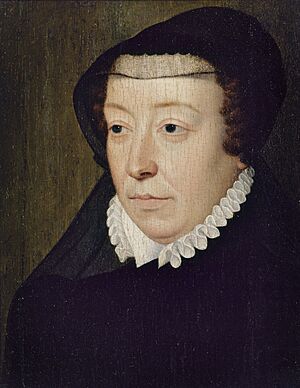
Catherine de' Medici, the Queen Mother of France, also claimed the Portuguese throne. She said she was a descendant of King Afonso III of Portugal. However, her claim was not taken seriously. She was a very distant relative and her family connection was not clear.
The Pope, Gregory XIII, also made a claim. Since King Henry was a cardinal, the Pope believed that all of Henry's property, including the Kingdom of Portugal, should go to the Church. These claims were not considered when deciding the next King of Portugal.
António of Portugal vs. Philip II of Spain
António, Prior of Crato (1531–1595) was one of the main people who wanted the Portuguese throne in 1580. Some historians even consider him King of Portugal for a short time. He ruled for 38 days in mainland Portugal in 1580. After that, he ruled from the Azores islands until 1583. António was the son of Prince Luis, and the grandson of King Manuel I. His claim was weak because he was born outside of marriage.
After King Sebastian died, António tried to claim the throne. But his claim was ignored in favor of Cardinal Henry. In January 1580, when a special meeting was held to choose an heir, King Henry died. A group of five people took over ruling the kingdom temporarily.
Philip II of Spain managed to get the support of Portugal's rich and powerful families. These nobles thought that joining with Spain would help Portugal's money problems. António, however, tried to get the support of the common people. He reminded them of a similar crisis in 1385. Back then, the King of Castile (Spain) tried to take the Portuguese throne. But an illegitimate son of the Portuguese king, John I, fought and won the Battle of Aljubarrota. This made John I the new king.
On July 24, 1580, António declared himself King of Portugal in Santarém. Many towns across the country supported him. His rule on the mainland lasted only 20 days. He was defeated in the Battle of Alcântara by Spanish armies. After Lisbon fell, he tried to rule from Terceira Island in the Azores. He even made his own coins, which is a sign of being a true ruler. Some people see him as the last king from the House of Aviz.
However, on the mainland and in the Madeira Islands, Philip II was recognized as king in 1580. He was officially named Philip I of Portugal in 1581. Philip's election came with a promise: Portugal and its overseas lands would stay separate from Spain. They would keep their own laws and government.
After his defeat in the Azores, António went to France, a country that was often against Spain. He also sought help from England. An invasion of Portugal was attempted in 1589 by Sir Francis Drake, but it failed. António continued to fight for his right to the throne until he died.
What Happened Next?
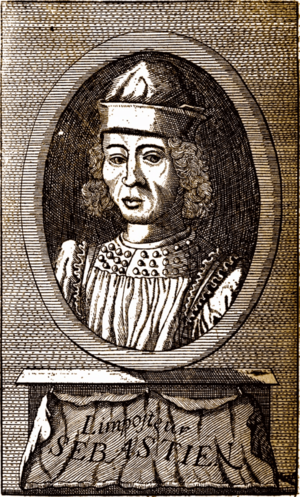
It's debated whether Spain truly invaded Portugal. Philip II had a valid claim to the throne, but like many royal family struggles, it was complicated. Life was generally calm under the first two Spanish kings. They kept Portugal's status and gave important jobs to Portuguese nobles in the Spanish court. Portugal also kept its own laws, money, and government. There was even a suggestion to move the capital of the Spanish Empire to Lisbon.
However, Portugal slowly lost its wealth. Even though it was an independent state, Portuguese colonies were attacked by their enemies, especially the Dutch and English.
Sixty years after these events, John II, Duke of Braganza (1603–1656) accepted the throne. Portuguese nobles were tired of Spanish rule. John was the grandson of Catherine, Duchess of Braganza, who had claimed the throne in 1580. He became King John IV of Portugal during the Portuguese Restoration War against King Philip IV of Spain.
Many people claimed to be King Sebastian after he disappeared. These "impostors" appeared in 1584, 1585, 1595, and 1598. The legend that the young king would return to Portugal on a foggy day, called "Sebastianism," lasted for many years, even into the 1800s.
Images for kids
-
Ranuccio Farnese, Hereditary Duke of Parma
-
Philip II, King of Spain
-
António of Portugal, Prior of Crato
-
Emmanuel Philibert, Duke of Savoy
See also
 In Spanish: Crisis sucesoria portuguesa de 1580 para niños
In Spanish: Crisis sucesoria portuguesa de 1580 para niños



